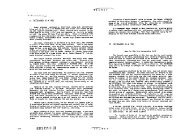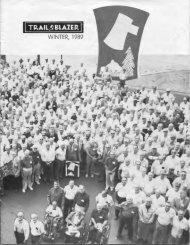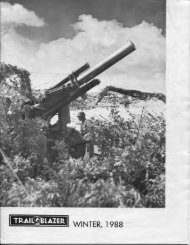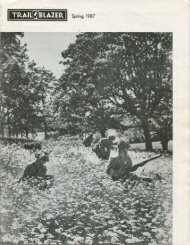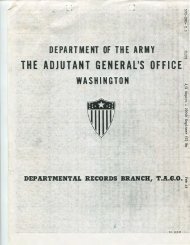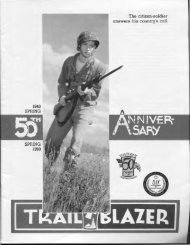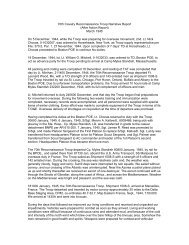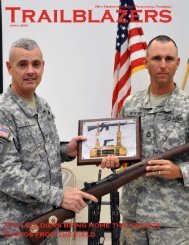Download - 70th Infantry Division Association
Download - 70th Infantry Division Association
Download - 70th Infantry Division Association
You also want an ePaper? Increase the reach of your titles
YUMPU automatically turns print PDFs into web optimized ePapers that Google loves.
The S-2 estimate of the enemy situation on 1 February was that there were elements of one regiment<br />
opposite our positions. The enemy line ran generally through the towns of Forbach, Oeting, Behren and<br />
Kerbach. Questioning of prisoners of war indicated that some of these troops were as old as 55 years.<br />
The state of morale, however, appeared to be satisfactory. More complete information was being<br />
obtained from the questioning of civilians than from prisoners of war.<br />
The S-2 report concluded that the enemy would outpost and defend his present positions, awaiting<br />
reinforcements; that if attacked the enemy would delay in successive positions until he reached the<br />
fortified area south of Saarbrucken, and that the enemy would continue to improve his present positions.<br />
In general, the 276th sector was quiet at this time.<br />
S-3 was preparing plans for withdrawal to defensive line as established by Headquarters TF HERREN.<br />
Reconnaissance was made of routes of withdrawal and work was under way on phase lines.<br />
Reconnaissance and planning were also going forward for a series of raids to be made in accordance<br />
with <strong>Division</strong> order.<br />
On February 1, 1945, two rounds of mortar fire fell on the position and no fire was returned. The enemy<br />
could not be located. On this date the First Lt. paid us and we got paid in allied marks. This was the first<br />
payday we had for a long time and we wondered why. For heaven's sake, here we were in enemy<br />
territory, fighting a war; on that particular day two rounds of mortar fell right in our company area and we<br />
were paid. No one understood that.<br />
On February 2, replacements required for the regiment were listed as 20 officers and 798 enlisted men.<br />
The supply situation was normal. The following vehicles were listed as lost or damaged: 16 1/4 T, one 2<br />
1/2 T, eight 1/4 T trailers, four 1 T trailers. Requests covering all of these had been submitted.<br />
On February 2 at Folkling, France, eight mortar rounds fell 100 yards from our mortar position--that was<br />
me. No fire was returned. The enemy could not be located. One-third of the company worked on position<br />
in line and the remainder of the company in position on defense line. In other words, the enemy had<br />
spotted us on our positions. On that particular day, the mortars were on the reverse slope of the hill and I<br />
was on the forward slope. I was an observer with our troops on the front lines. Now this hill had no trees,<br />
was covered with snow and had no buildings. It was like an abandoned, snow-covered wheat field. I was<br />
with one other man, my platoon runner PFC Wilfred Sencindiver, in a hole.<br />
That night the hole started to melt. I was lying on a board in the hole and had the board laying against the<br />
side of the hole. When I woke up early in the morning, my feet were in water and so were my buddy's<br />
feet. He was supposed to be wide awake, but was snoring with his feet deep in water. We could not<br />
evacuate the hole. The edges of the hole were thawing, making a neat black ring around the hole, a<br />
perfect target for the enemy.<br />
The enemy took out his field glasses, looked over and saw our position and fired mortar rounds near us.<br />
You get five rounds to knock out a target. A mortar has a bursting range of 19'6" across the diagonal. It<br />
was strictly concussion, very little shrapnel. You would set the gun up and fire. It didn't matter where the<br />
first round landed. You just wanted to settle the base plate and get the gun solid so there would be no<br />
movement. When the first round exploded near your target, you could calculate your corrections and<br />
adjust your gun to bring one burst under the target. The philosophy was that you would fire one over and<br />
one short, then adjust right on your target. One over, one short, and then three rounds to hit.<br />
Okay, new here we go. It's dawn, beginning to lighten and warm up. It's muddy; we are wet; we are cold<br />
and we are hungry. We haven't slept right; we haven't eaten; we haven't done anything worthwhile. Our<br />
feet are soaking wet and I look out the hole and see and hear a burst of shell fire behind me. I look in<br />
front of me and see another shell fall in front of me. I tell my buddy, "That's for us, so let's get cut of here."<br />
So we get cut of the hole and start running to the rear, the reverse side of the hill. As we ran, the enemy<br />
fired three on our position. They were near misses. They did not hit the hole. They came close. As they<br />
saw us running, the Germans fired three on the reverse slope of the hill. Of course, his shells went over



